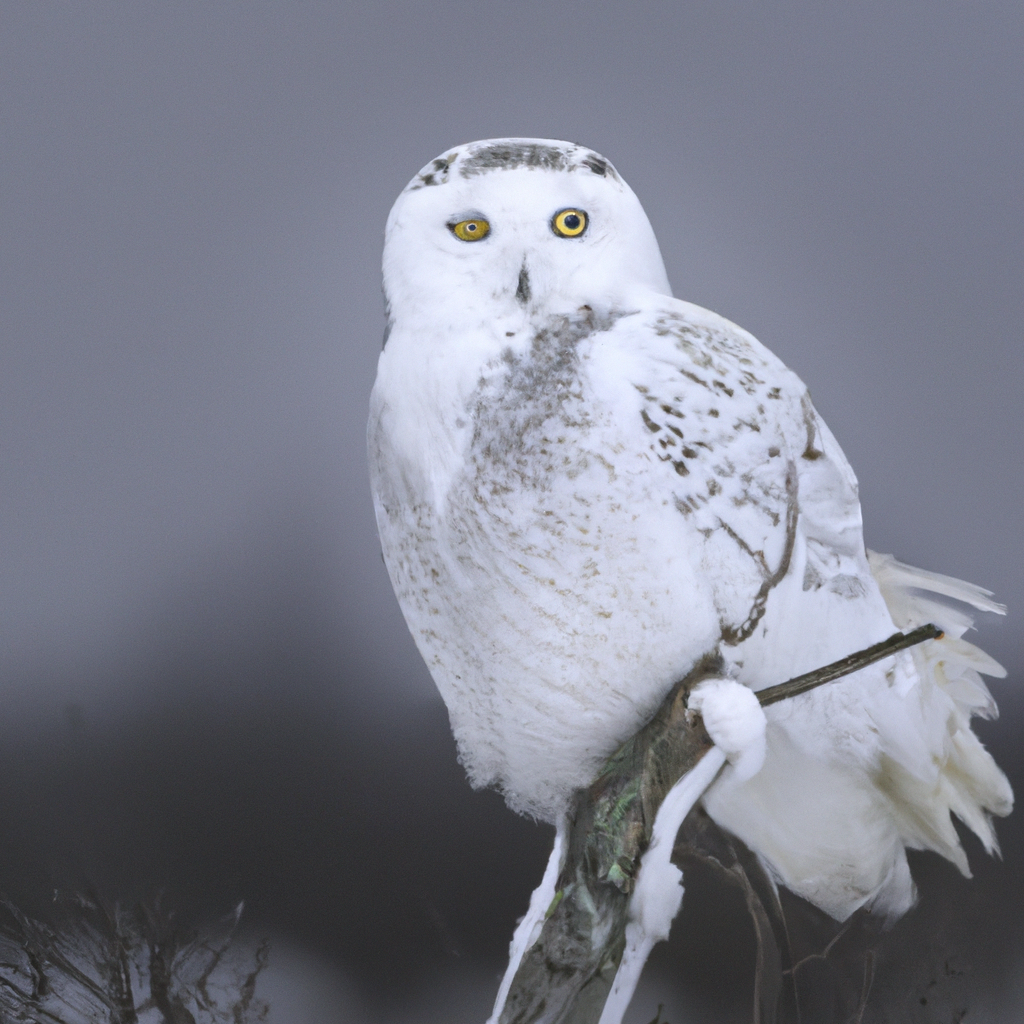The Snowy Owl (Bubo scandiacus) is a captivating species renowned for its distinctive white plumage and piercing yellow eyes. With a wingspan of up to 5 feet, this majestic bird is one of the largest owl species in the world. Found in the Arctic regions of North America, Europe, and Asia, the Snowy Owl is well adapted to its frigid habitat, possessing thick feathering and keen predatory instincts. Despite its enchanting appearance, the Snowy Owl is a fierce hunter, preying on a variety of small mammals and birds. Its ability to withstand the harsh Arctic climate and its exceptional beauty make the Snowy Owl a truly remarkable creature to behold.
Habitat
Tundra regions
The Snowy Owl is primarily found in tundra regions, which are characterized by low temperatures, permafrost, and a lack of trees. These regions are typically located in the far northern areas of the globe, such as the Arctic and subarctic regions. The Snowy Owl is well-adapted to this harsh environment, with its thick plumage and large size.
Coastal and agricultural areas
While the Snowy Owl is most commonly associated with tundra regions, it can also be found in coastal and agricultural areas. In coastal regions, Snowy Owls may take advantage of the abundance of prey, such as fish and birds, that can be found near the water. In agricultural areas, they may hunt rodents that are attracted to crops, making these areas a viable habitat for the owl.
Physical Description
Large size
Snowy Owls are known for their large size, with females being larger than males. On average, females can reach a length of 22-28 inches (56-71 cm) and have a wingspan of 4.2-4.8 feet (1.3-1.5 meters). Males, on the other hand, are typically slightly smaller. This size difference is known as sexual dimorphism.
Plumage
The Snowy Owl has beautiful white plumage, which helps it blend in with its snowy surroundings. However, their plumage can also vary depending on the season. During the summer months, adult males may have a few dark feathers on their back and wings, while females and juveniles may have more extensive markings. In the winter, their plumage is predominantly white, helping them to camouflage against the snow.
Sexual dimorphism
One of the distinguishing features of the Snowy Owl is the presence of sexual dimorphism. As mentioned earlier, females are larger than males. Additionally, adult males have a whiter appearance, while females and juveniles may have darker markings on their feathers. This dimorphism is thought to be related to the different roles and behaviors of males and females in the breeding process.

This image is property of images.unsplash.com.
Diet
Rodents
The Snowy Owl primarily feeds on rodents, such as lemmings and voles. These small mammals are abundant in their tundra habitat, making them an important food source for the owls. Snowy Owls have excellent hunting skills and can spot their prey from high perches or while in flight. Once they have located their target, they swoop down and catch the rodents with their sharp talons.
Birds
In addition to rodents, Snowy Owls also feed on birds. This is especially true during the breeding season when birds are nesting and are more vulnerable to predation. Common targets include waterfowl, such as ducks and geese, as well as smaller birds that may be found in their habitat. Snowy Owls use their powerful beaks and talons to capture and kill their avian prey.
Fish
Snowy Owls are also known to eat fish, particularly in coastal areas where this food source is readily available. They may swoop down and snatch fish from the water’s surface, or they may hunt near the shores and catch fish that are closer to the surface. This adaptation allows them to take advantage of the abundance of fish found in these habitats.
Insects
While not as significant as rodents, birds, or fish, Snowy Owls have been observed feeding on insects in their habitat. Insect prey may include beetles, grasshoppers, and other small arthropods. While the exact role of insects in the Snowy Owl’s diet is not well-understood, it is likely that they serve as an additional food source when other prey is scarce.
Breeding
Nesting sites
Snowy Owls typically build their nests on the ground, using mounds or hummocks on the tundra as a base. This provides adequate protection for the eggs and chicks, shielding them from the harsh weather conditions. The female Snowy Owl will use her own feathers to line the nest, creating a soft and warm environment for the eggs and later, the young owls.
Mating
The mating rituals of Snowy Owls usually occur during the breeding season, which varies depending on the location. Males will engage in courtship displays to attract females, which may include aerial acrobatics, calling, and wing spreading. Once a female is chosen, mating takes place. Pairs of Snowy Owls are usually monogamous for the duration of the breeding season.
Incubation period
After mating, the female Snowy Owl will lay a clutch of 3-11 eggs, with an average of 5-7 eggs. The incubation period lasts approximately 32-34 days, during which time the female remains on the nest to keep the eggs warm and protected. The male is responsible for providing food for both the female and the growing chicks.
Juvenile development
Once the eggs hatch, the female Snowy Owl will continue to care for the chicks, while the male continues to provide food. The chicks are covered in white down feathers and are dependent on their parents for nourishment and protection. After about 6 weeks, the young owls will start to develop flight feathers and will eventually leave the nest. They will remain close to their parents for a period of time, learning to hunt and survive in their environment.

This image is property of images.unsplash.com.
Migration
Arctic breeding grounds
Snowy Owls breed in the Arctic regions, using the tundra as their nesting grounds. This vast expanse of land provides an abundance of prey for the owls and allows them to raise their young in a suitable environment. During the breeding season, the owls will establish territories and defend them from intruders. Once the young have fledged, both adults and juveniles will begin their migration.
Southern wintering locations
Snowy Owls are known for their long-distance migration, with some individuals traveling thousands of miles to reach their wintering grounds. While the exact locations can vary, Snowy Owls have been observed wintering in various parts of North America, including the northern United States and Canada. Coastal areas are particularly attractive to these owls, as they provide a consistent food source and suitable habitat.
Long-distance migration
Snowy Owls are considered one of the most migratory owl species, with individuals traveling long distances between their breeding and wintering grounds. The exact route and distance can vary between individuals, but some have been recorded traveling over 1,500 miles (2,414 km). This long-distance migration is believed to be influenced by factors such as food availability, weather patterns, and breeding success.
Communication
Hunting calls
Snowy Owls are generally silent birds, but they do produce various calls during hunting. These calls are often used to attract prey or communicate with other owls in the vicinity. One of the most common hunting calls is a series of hoots, similar to the “hoo-hoo-hoo” sound often associated with owls. These calls can carry over long distances and help the owls locate each other while hunting.
Breeding calls
During the breeding season, Snowy Owls produce a variety of vocalizations to attract mates and establish territories. Males in particular are known for their distinctive breeding calls, which can be described as a mix of hoots, barks, and screams. These calls are used to signal their presence and attract females, as well as to deter rival males from entering their territory.
Territorial displays
Snowy Owls are territorial birds, and they use a range of displays to establish and defend their territories. These displays can include raising and lowering their wings in a slow and deliberate manner, fluffing up their feathers to appear larger, and engaging in aerial acrobatics. These territorial displays are often accompanied by vocalizations and help to communicate dominance and deter intruders.

This image is property of images.unsplash.com.
Predators
Arctic fox
Arctic foxes are one of the main predators of Snowy Owls in the Arctic regions. These foxes are opportunistic hunters and will take advantage of any available food source, including the eggs and chicks of Snowy Owls. They are agile and skilled hunters, making them a significant threat to the owl population in these areas.
Polar bear
While not a direct predation threat to Snowy Owls, polar bears can inadvertently disturb or destroy owl nests while searching for food. These large predators are known to travel across the tundra, and their presence can disrupt the breeding success of Snowy Owls. The destruction of nests can lead to the loss of eggs or chicks, impacting the overall population of the owls.
Glaucous gull
Glaucous gulls are known to prey on Snowy Owl chicks, especially when they are vulnerable and unable to defend themselves. Glaucous gulls are opportunistic feeders and will scavenge for food or prey on other birds’ nests. Their predation on Snowy Owl chicks can significantly impact the breeding success and overall population of the owls in certain areas.
Conservation Status
Population decline
The Snowy Owl population has faced significant declines in recent decades. Factors such as climate change, habitat loss, and human disturbance have contributed to this decline. The warming of the Arctic and reduction of sea ice affect the availability of prey for the owls, leading to a decrease in breeding success and overall population size.
Protected areas
Efforts are underway to protect Snowy Owls and their habitats through the establishment of protected areas. These areas help to preserve critical breeding and wintering grounds for the owls and provide them with the necessary resources to survive. Additionally, conservation organizations are working to raise awareness about the importance of Snowy Owl conservation and engage in research and monitoring efforts.
Threats & conservation measures
Human disturbance, such as recreational activities and disturbance of nesting sites, can negatively impact Snowy Owls. It is essential for visitors to tundra regions and coastal areas to be respectful of the owls’ habitats and practice responsible wildlife viewing. Conservation measures should include habitat preservation, research on migration patterns, and education to promote awareness and understanding of the threats facing Snowy Owls.

Cultural Significance
Symbolism in various cultures
The Snowy Owl holds cultural significance in various cultures around the world. In some Native American cultures, it is considered a symbol of wisdom and intuition. Its ability to navigate through the darkness and its mysterious nature make it a revered and respected symbol. In other cultures, the Snowy Owl may represent purity, grace, or even an omen of good fortune.
Owl as a spirit animal
In spiritual and metaphysical practices, the Snowy Owl is often associated with the concept of spirit animals. Spirit animals are believed to offer guidance, protection, and insight to individuals who connect with them. The Snowy Owl, with its keen senses and ability to navigate the darkness, may be seen as a symbol of clarity, wisdom, and intuition in these practices.
Research and Study
Tracking and monitoring
Researchers and scientists have been studying Snowy Owls to better understand their migration patterns and behavior. This involves tracking individual owls using technology such as satellite transmitters and GPS to monitor their movements and gather data. Tracking and monitoring efforts help identify key habitats, migration routes, and potential threats to the owl population.
Migration patterns
Understanding the migration patterns of Snowy Owls is crucial for their conservation. Researchers have used tracking data to uncover the routes and timing of their migrations, which can vary between individuals and years. By studying these patterns, scientists can gain insights into the reasons behind their long-distance journeys, the impact of environmental changes on their migration, and potential conservation strategies.
In conclusion, the Snowy Owl is a magnificent bird that inhabits tundra regions, coastal areas, and agricultural landscapes. Its large size, beautiful plumage, and distinct sexual dimorphism make it a truly remarkable species. The Snowy Owl’s diet consists of rodents, birds, fish, and insects, which it hunts with precision and agility. During the breeding season, the owl nests on the ground, engages in intricate mating rituals, and raises its young until they are ready to leave the nest. Migration is a significant part of the Snowy Owl’s life, with individuals traveling great distances between their Arctic breeding grounds and southern wintering locations. Communication is essential for these owls, as they use various calls and displays to communicate with each other during hunting, breeding, and territorial interactions. The Snowy Owl has natural predators, such as the Arctic fox, polar bear, and glaucous gull, which can impact its population. Conservation efforts are crucial to protect the Snowy Owl, including the establishment of protected areas, research and monitoring, and raising awareness about the threats it faces. Moreover, the Snowy Owl holds cultural significance in different cultures, representing wisdom, purity, and intuition. Finally, scientific research and study are vital to understanding the Snowy Owl’s migration patterns and behavior, ensuring its long-term survival.

